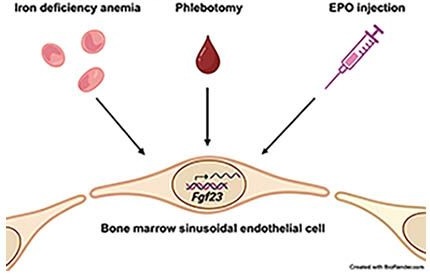



Iron deficiency is a potent stimulator of fibroblast growth factor 23 (FGF23), a hormonal regulator of phosphate and vitamin D metabolism, that is classically thought to be produced by bone-embedded osteocytes. Here, we show that iron-deficient transmembrane serine protease 6 knockout (Tmprss6-/-) mice exhibit elevated circulating FGF23 and Fgf23 messenger RNA (mRNA) upregulation in the bone marrow (BM) but not the cortical bone. To clarify sites of Fgf23 promoter activity in Tmprss6-/- mice, we introduced a heterozygous enhanced green fluorescent protein (eGFP) reporter allele at the endogenous Fgf23 locus. Heterozygous Fgf23 disruption did not alter the severity of systemic iron deficiency or anemia in the Tmprss6-/- mice. Tmprss6-/-Fgf23+/eGFP mice showed green fluorescence in the vascular regions of BM sections and showed a subset of BM endothelial cells that were GFPbright by flow cytometry. Mining of transcriptomic data sets from mice with normal iron balance revealed higher Fgf23 mRNA in BM sinusoidal endothelial cells (BM-SECs) than that in other BM endothelial cell populations. Anti-GFP immunohistochemistry of fixed BM sections from Tmprss6-/-Fgf23+/eGFP mice revealed GFP expression in BM-SECs, which was more intense than in nonanemic controls. In addition, in mice with intact Tmprss6 alleles, Fgf23-eGFP reporter expression increased in BM-SECs following large-volume phlebotomy and also following erythropoietin treatment both ex vivo and in vivo. Collectively, our results identified BM-SECs as a novel site for Fgf23 upregulation in both acute and chronic anemia. Given the elevated serum erythropoietin in both anemic models, our findings raise the possibility that erythropoietin may act directly on BM-SECs to promote FGF23 production during anemia.
This work was supported by NIDDK U54 DK106857 at the Yale Cooperative Center for Excellence in Hematology.
